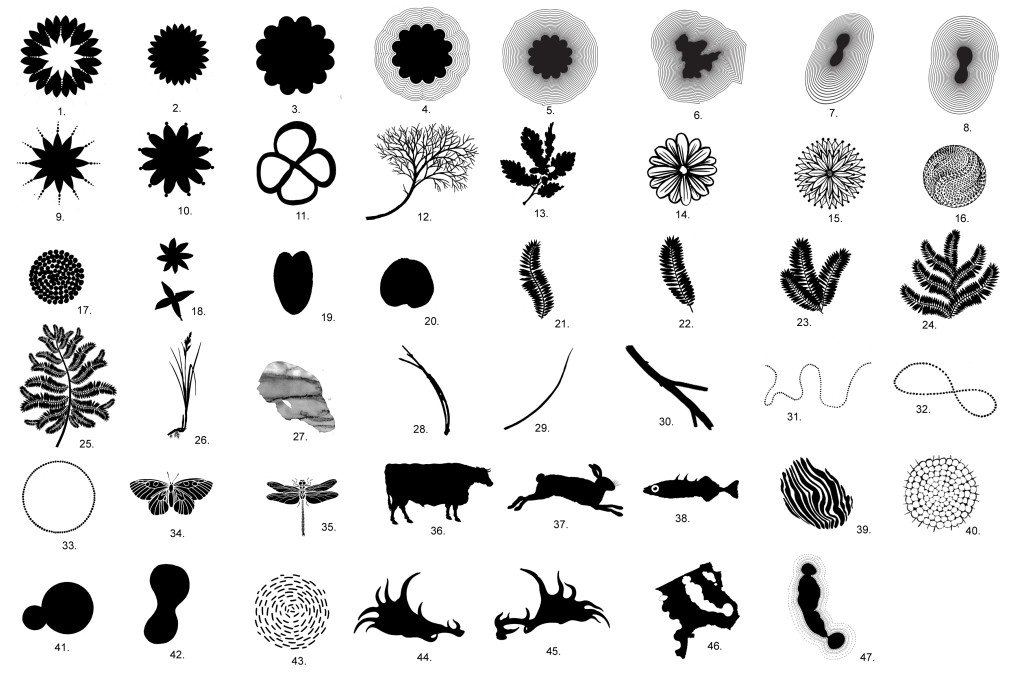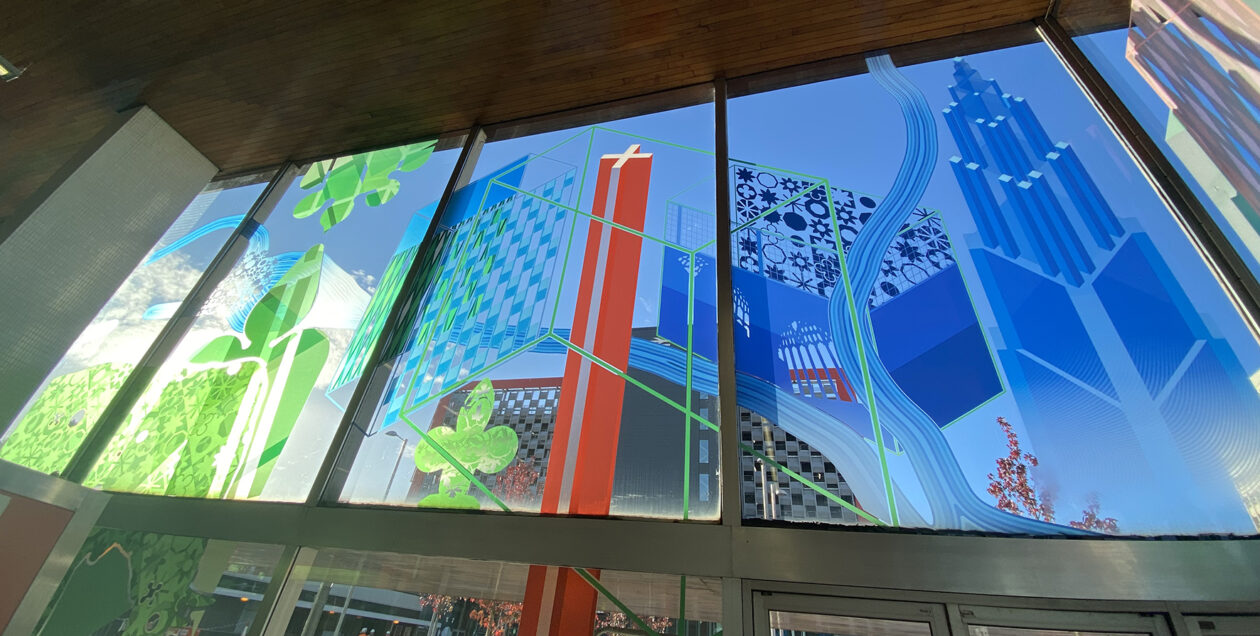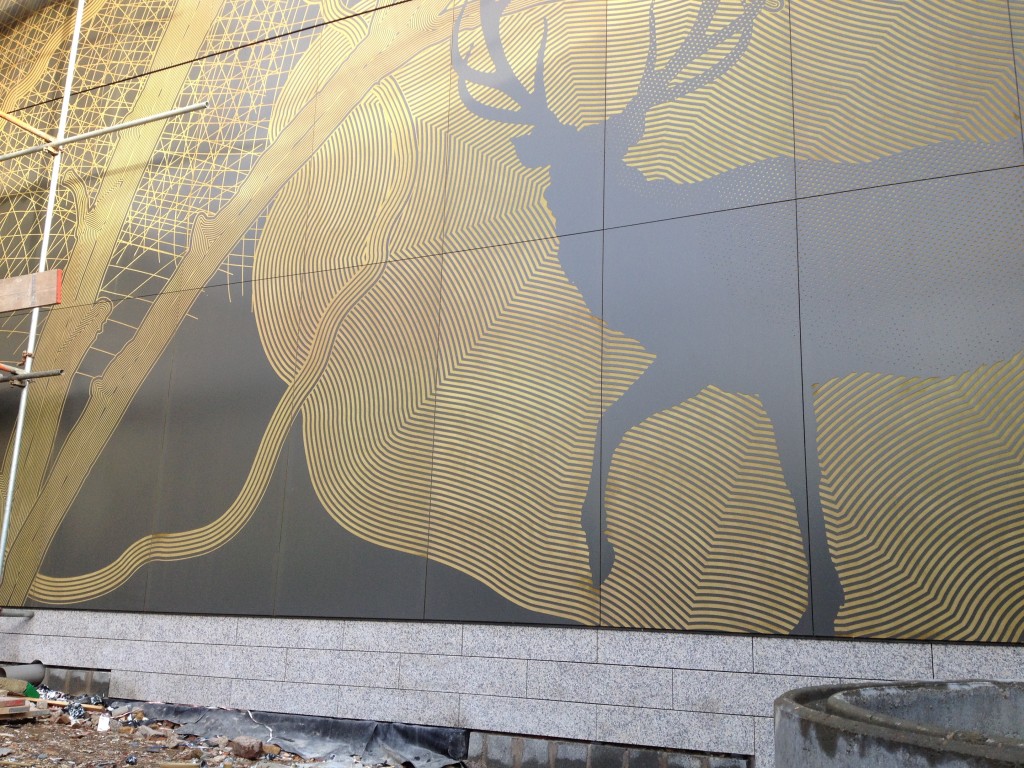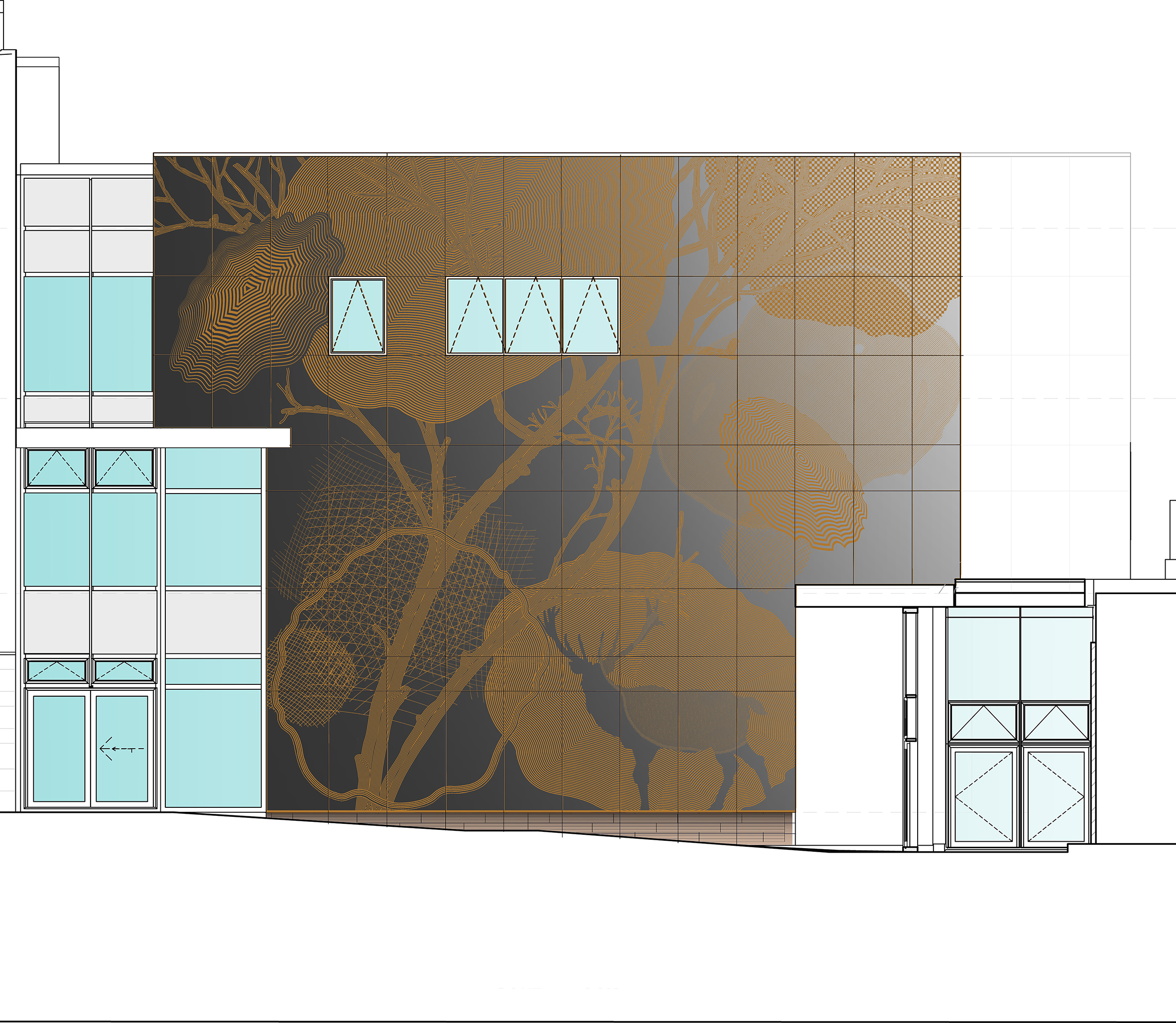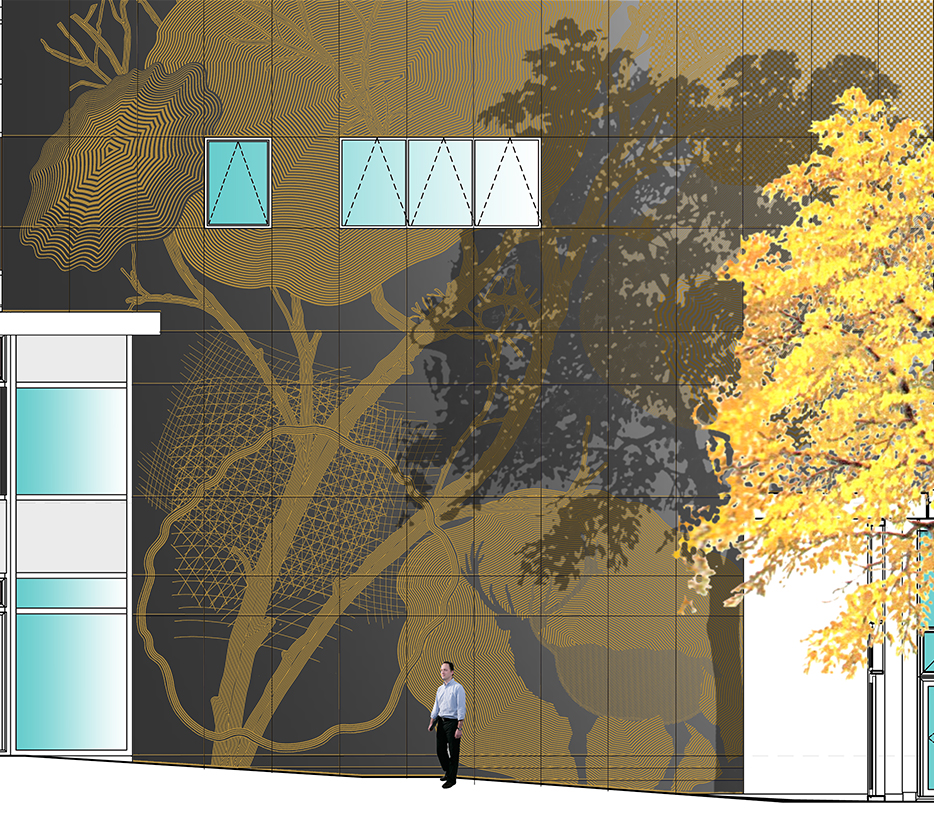Tuesday 26th August Glazing manifestation artworks for the ‘Heart of the Campus’ building, for Sheffield Hallam University, Collegiate Campus. DIGITALLY PRINTED WHITE INKS OVERLAIN IN OPAQUE & TRANSPARENT LAYERS ONTO OPTICALLY CLEAR VINYL . Phase 1 of the installation by VGL has now completed, but I have yet to get images of the completed works on site. The following images are of the approved production artwork for Phase 1. We are now awaiting confirmation that the Phase 2 project will be put into production. 
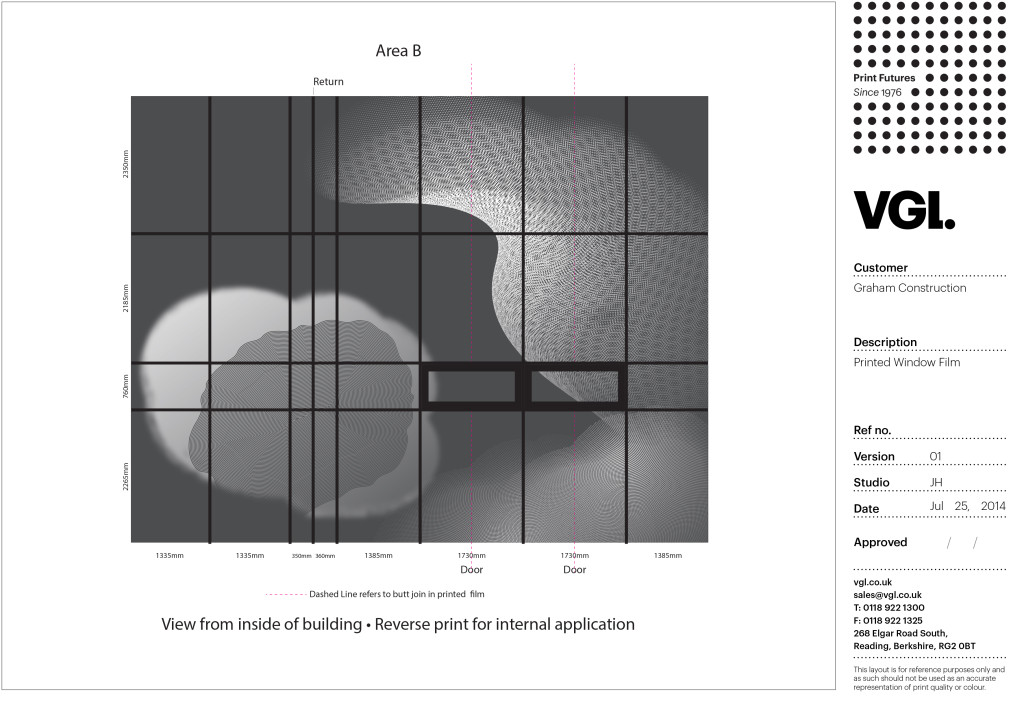
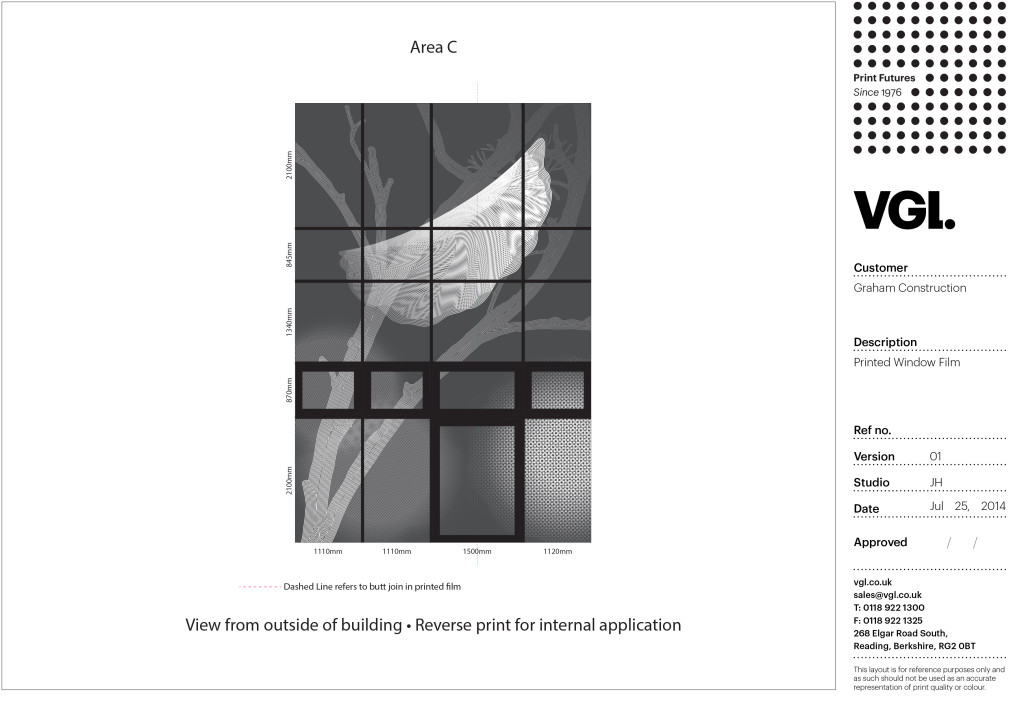
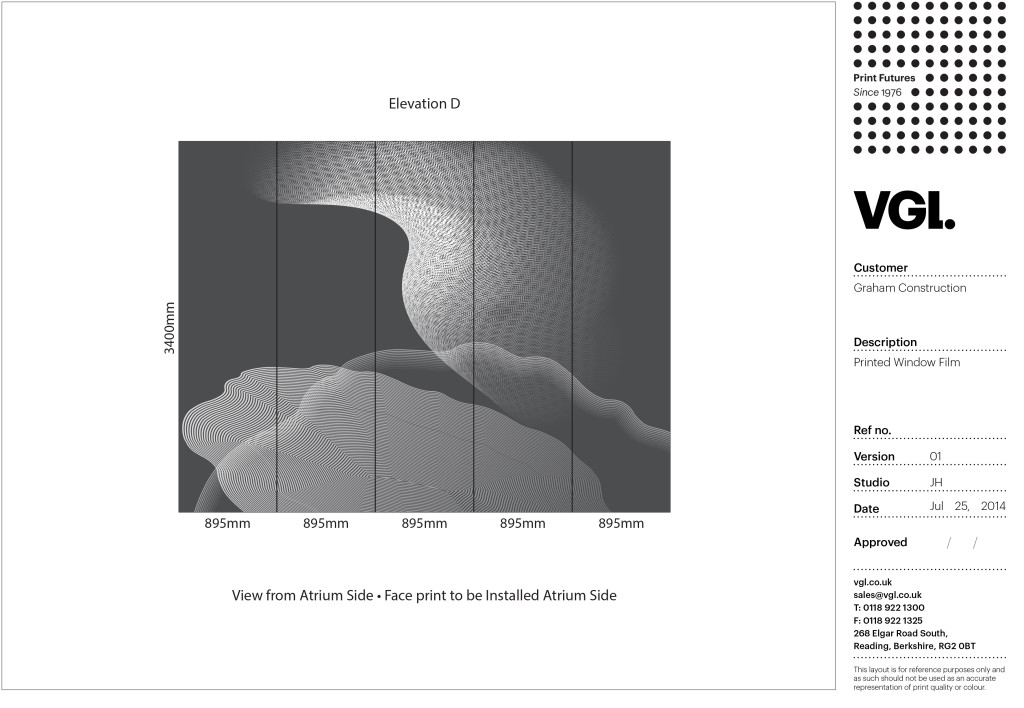
Category Archives: Education
Covers all projects which involve either educational institutions such as schools, colleges and universities.
‘Heart of the Campus’. Site visit with VGL
Friday 27th June.
GLAZING MANIFESTATION ARTWORKS TO THE ‘HEART OF THE CAMPUS’ BUILDING FOR SHEFFIELD HALLAM UNIVERSITY, COLLEGIATE CAMPUS .
DIGITALLY PRINTED WHITE INKS OVERLAIN IN OPAQUE & TRANSPARENT LAYERS ONTO OPTICALLY CLEAR VINYL .
Up to Sheffield to walk around site with Carly Birkett of VGL . I am developing the glazing manifestation artwork in collaboration with VGL and we have limited time to get this project developed and installed. As usual the project contractors, Graham Construction were really helpful on site and assisted in the process of taking all ‘as built’ measures of the glazing screens which will take the artwork.
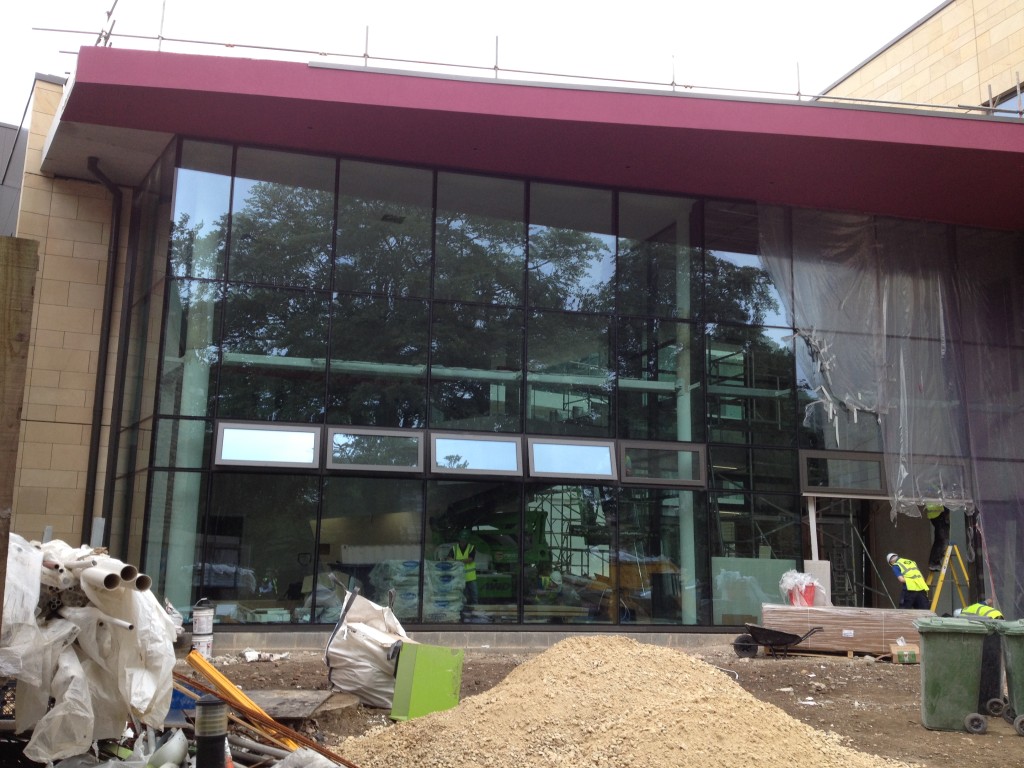
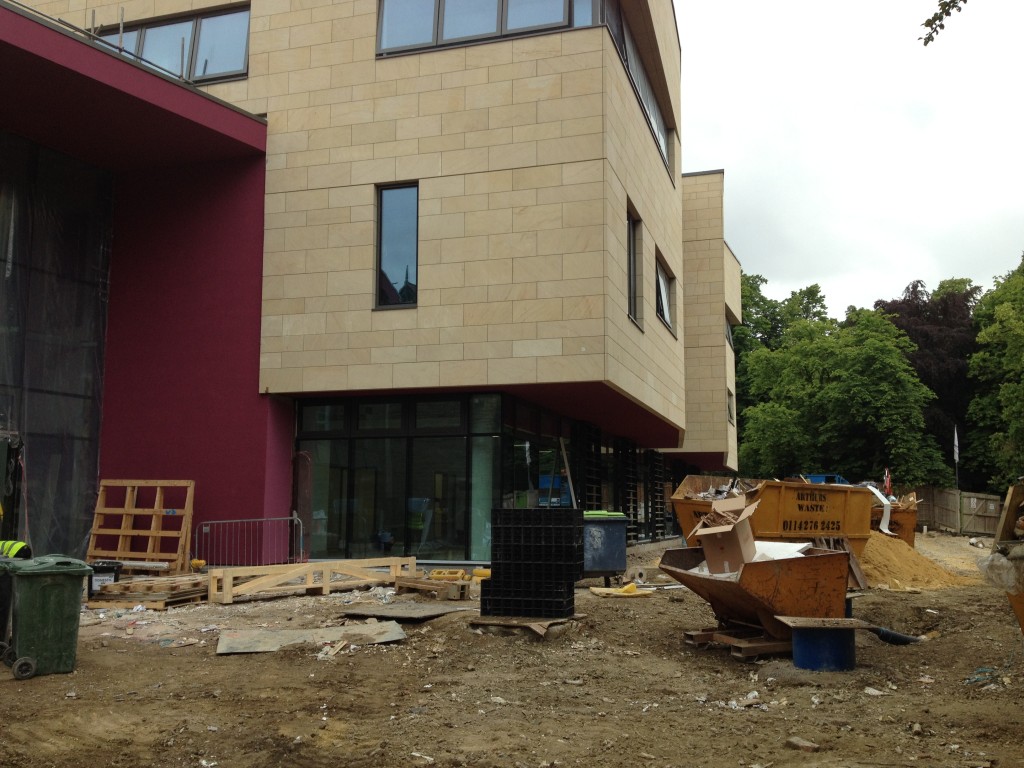
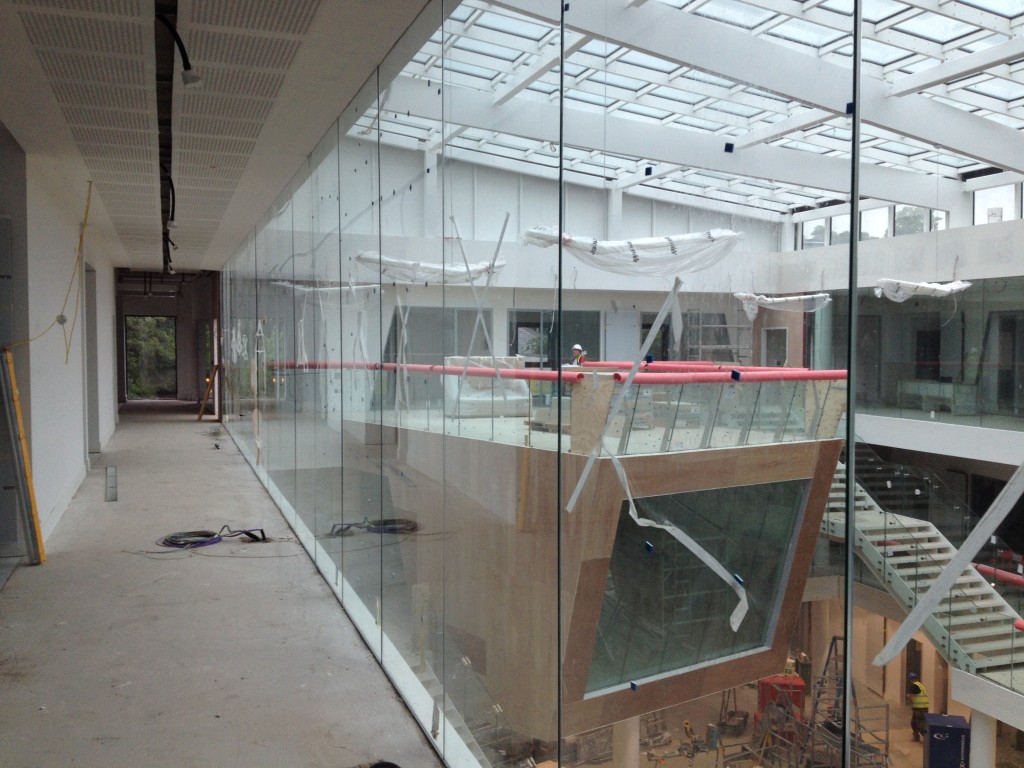


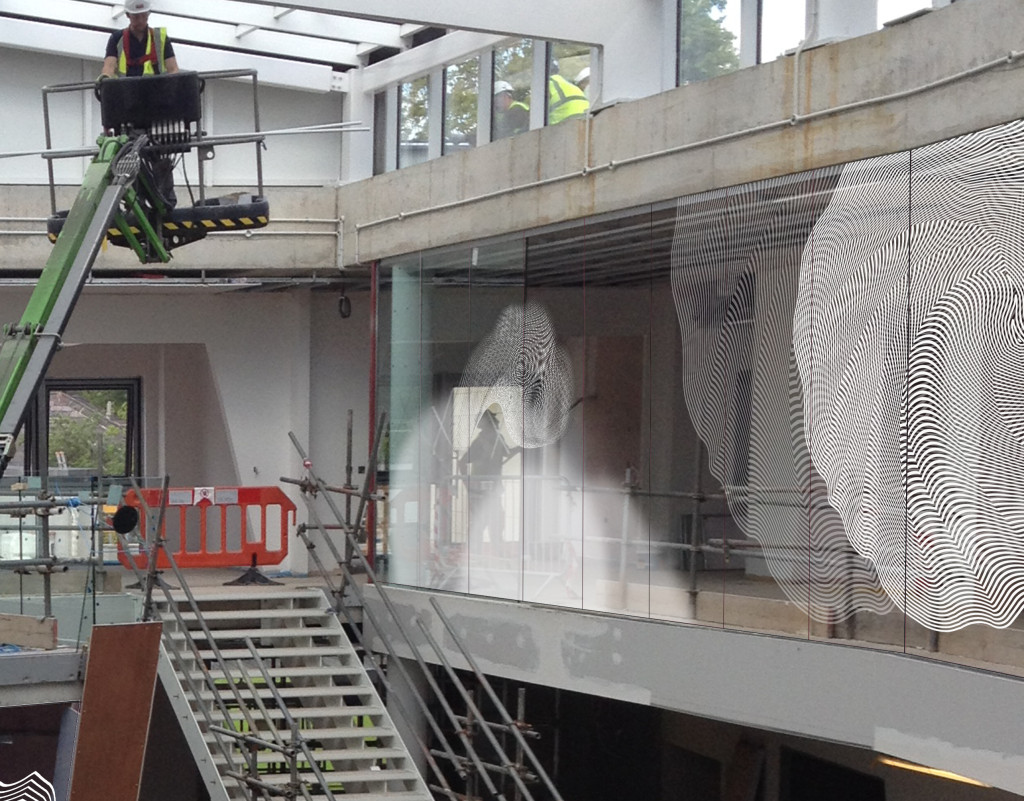

The proposals for glazing manifestations is a continuation of the west elevation Rockpanel rains creen artwork, where cnc routed detailed drawings where been used to create a hard edged and graphic finish, dictated in part by its design influences in historic printmaking and metalworking in Sheffield and by the materials and methods of its own production. The manifestation artworks being are created using the same base visual language & influences developed & explored in the Rockpanel work. This proposal expands upon this concept to explore a softer more fluid application concerned with lightness, detail, transparency & opacity to create a balancing contrast to the dynamic geometry & scale of the building. ‘The designs are abstract & cloud-like, suggesting ephemeral objects, floating within the architectural space from the ground floor to the very top of the atrium roof. The interactions of the various patterns and forms, overlaying and meeting to create new shapes, details and transparencies suggest a coalescing of conversations, interactions, disciplines and dialogue. The exhalations & energy of everyone who may use this new building are manifest here’. The digitally printed vinyl manifestation is applied to the glazing directly which requires a lighter touch than the West Elevation artwork. The detail and narrative appear as if blown and drifted through the building. This project is a continuation, extension and elaboration of the recently completed West Elevation Rockpanel Rainscreen artwork, where cnc routed detail has been used to create a hard edged and graphic appearance, dictated in part by its origins in printmaking and metalworking and the materials and methods of its production. The original concept was developed as a contextual research document, which still stands as the concept driver for the project and is submitted for reference along with this presentation. ‘The manifestation artworks being proposed in draft form here are created from the same base visual language developed for the Rockpanel Rainscreen works of the west elevation, but expands upon this concept to explore a softer more fluid application concerned with light, space & transparency to create a balancing contrast to the dynamic geometry of the building.
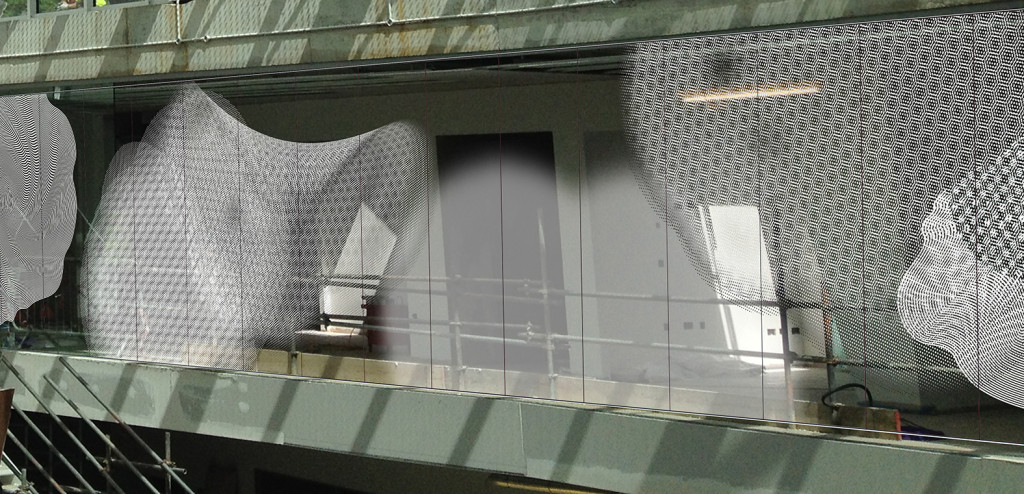
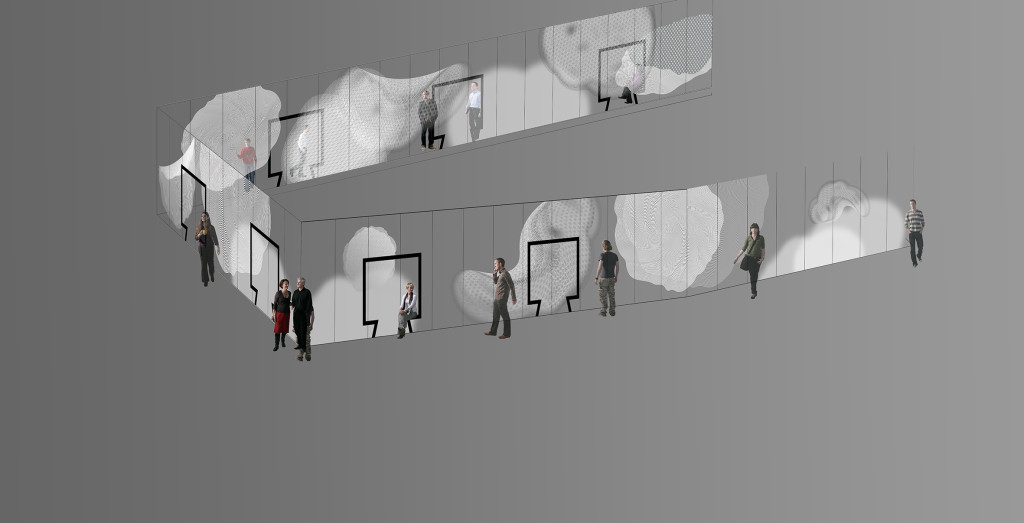
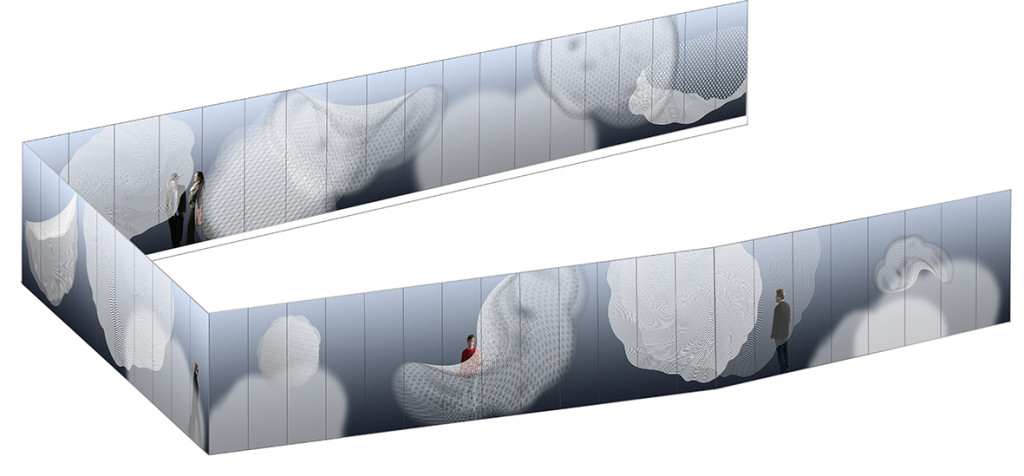

‘Heart of the Campus’, Sheffield Hallam University Collegiate Campus
14th May 2014
I made a site visit to the Heart of the Campus building along with Andrew Illingworth, Interior Designer for HLM Architects & Garry Farmer, Project Manager for Graham Construction, the main contractors on the project. Seen from Collegiate Crescent, the building is just visible behind the mature Beech trees.

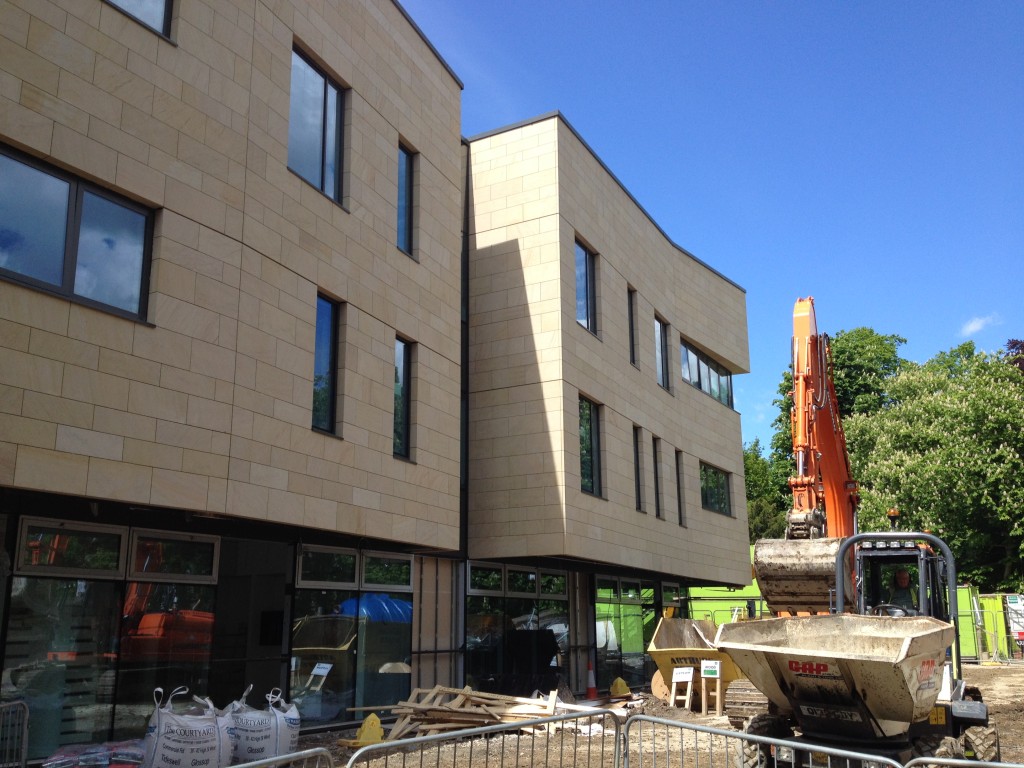
I have been commissioned to extend the original brief for a cnc routed Rockpanel rainscreen on the West Elevation to include digitally printed vinyl manifestations for the East Elevation glazed curtain wall and interiors. This was an incredibly useful visit as the building has really moved forward since my last time here in January this year.
The interior atrium is three storeys high and filled with light. It is a dynamic architectural space which has as a centrepiece, a cantilevered cube projecting out from the first floor. When sunlight floods in via the fully glazed atrium roof, the whole building is suffused with light and shadows.
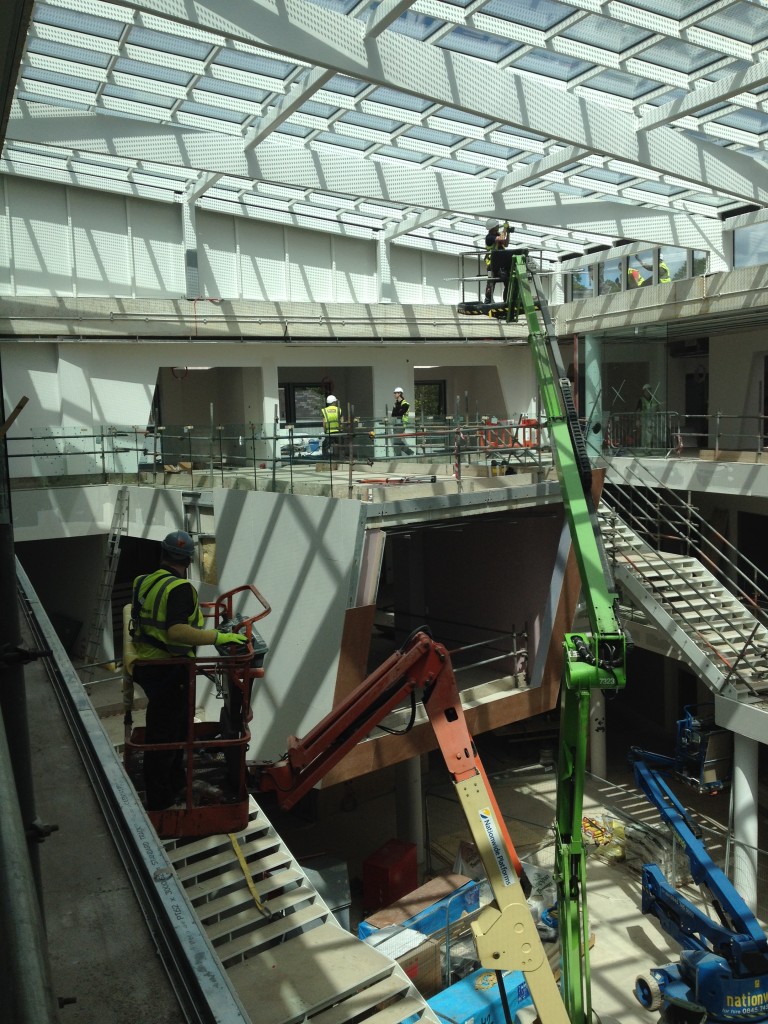



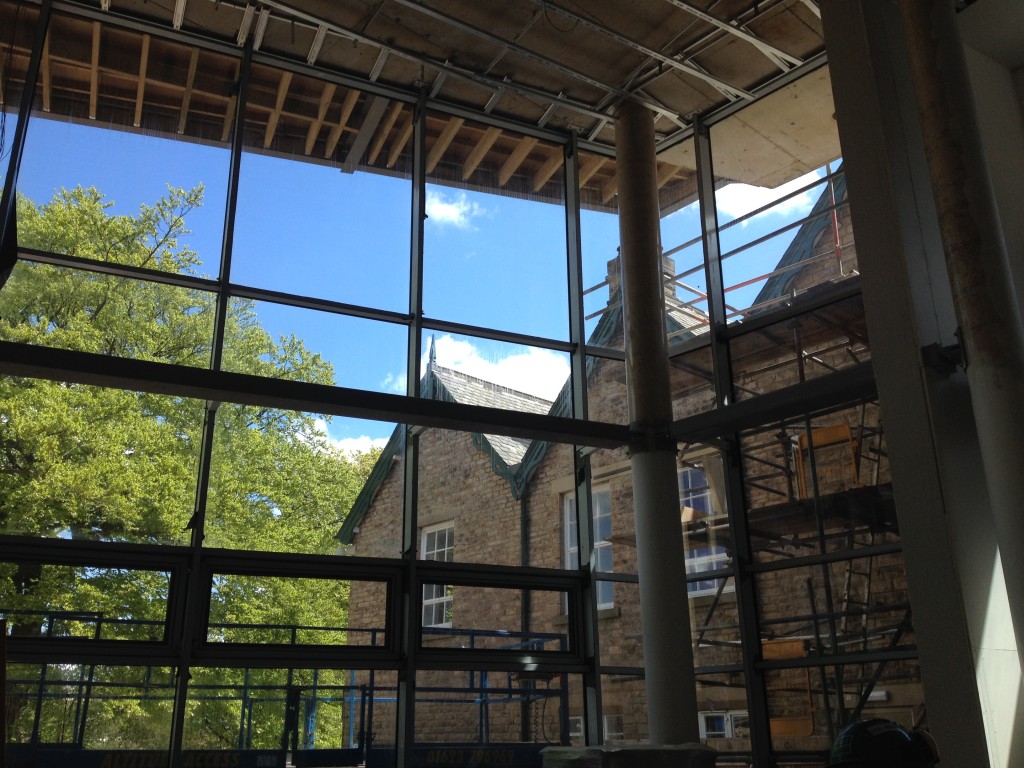

Whilst on site I couldn’t resist a quick look at the West Elevation Rockpanel ‘drawing’. This artwork is cnc routed into the rain screen panels & was manufactured by The Cutting Room in Huntingdon. The exposed base material, almost a bright yellow colour when first exposed, darkens in contact with sunlight and has now achieved its permanent shade. This is more subtle then when first installed, & has now blended in with its architectural setting. Up close, the detail is crisp and casts strong shadows on a sunny day.
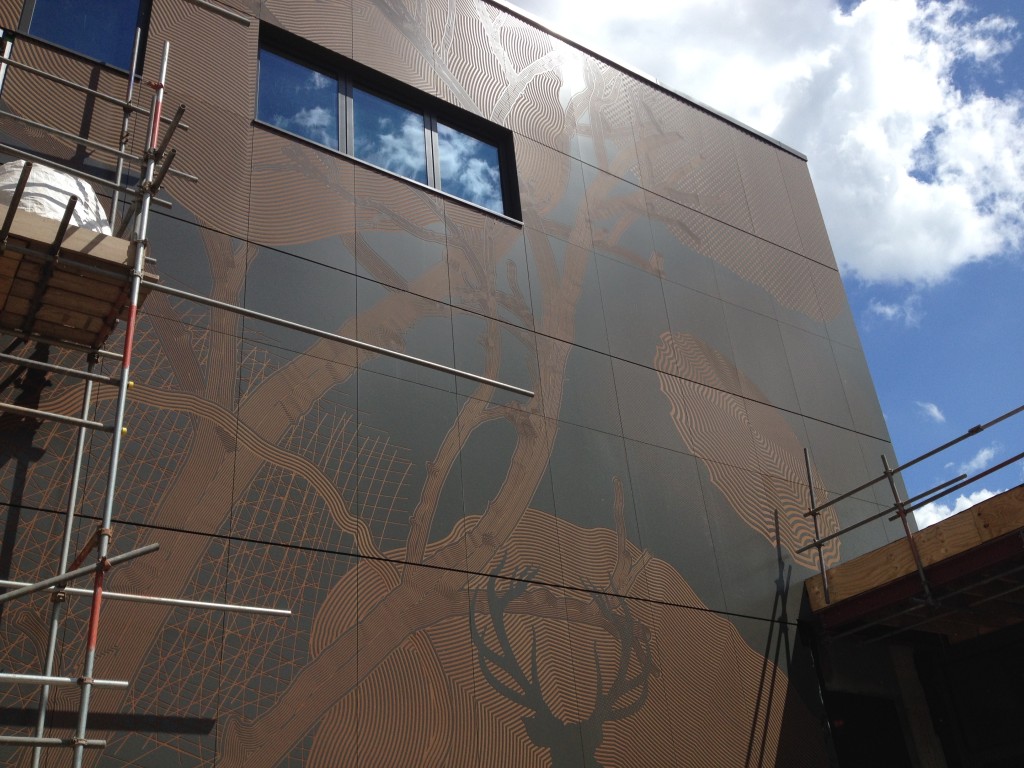
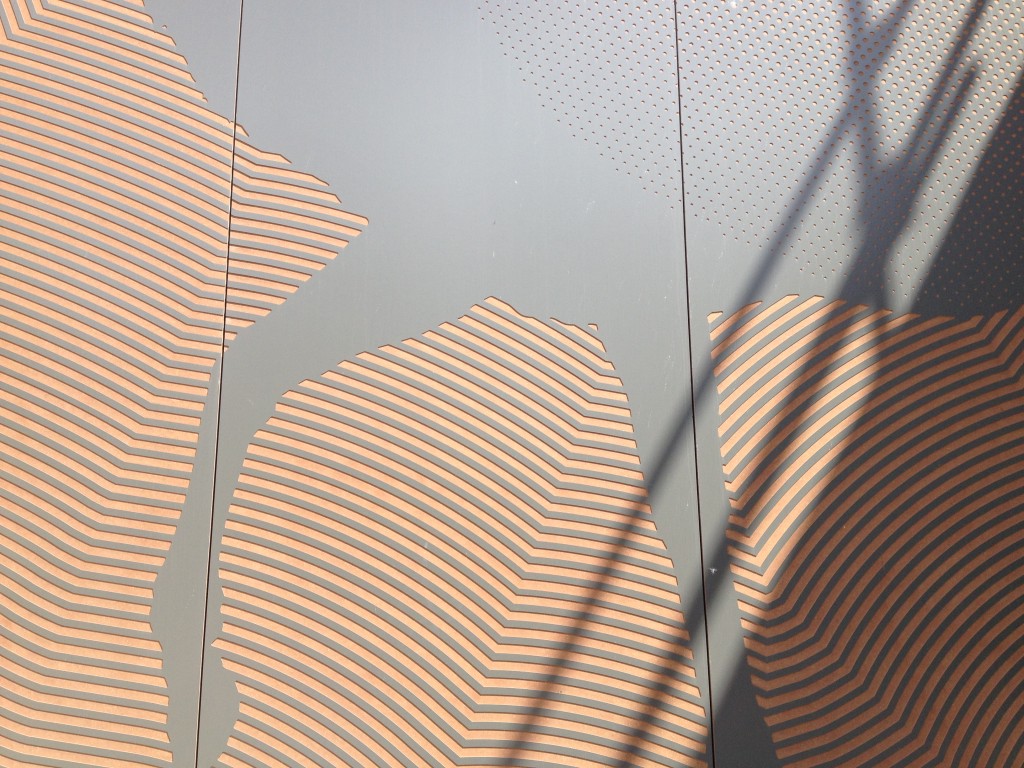


The first drafts for the glazing manifestations were produced in January this year and use the same iconography as the West Elevation cnc work. The manifestations however, being digitally printed, have no need for hard edges and manageable cutting paths. The designs will work with transparency and light to achieve their results. Digital printing further allows for a range of softer and finer details to be introduced. This is what I am currently working on. The manifestations serve a distinct purpose and have to comply with building regulations. Beyond that, the artwork can develop in many original ways to drift through the building.
‘Heart of the Campus’, Sheffield Hallam University Collegiate Site
The installation of the Heart of the Campus West Elevation ‘Drawing’ artwork was started on site in November 2013 & is nearing completion.
Project Outline
The images all relate to an external artwork created for a section of the Western Elevation of the Heart of the Campus building, which faces onto Broomgrove Rd in Sheffield.
The Heart of the Campus building has been commissioned by Sheffield Hallam University. The project is being delivered on site by GRAHAM, along with Architects HLM and Project Managers Turner Townsend.

This elevation functions as a façade rain screen of grey colour-coated 10mm thick panels, manufactured by Rockpanel. It is proposed that the artwork will be formed via cnc routing of this surface, which will expose the base material to a depth of 2mm. When routed, the exposed base material is a greenish yellow, which eventually weathers to a rich brown colour over several weeks.The panels will be invisibly fixed to the sub-base frame & have a joint width of 5mm.
The themes explored in the work are conveyed through dynamic mark making and linear drawing evoking the history of cutlery manufacture in the city and techniques associated with printmaking, engraving, chasing and the evidence of the individual maker. These methodologies have found their way into every nook of the manufactory in Sheffield.
The narrative artwork forms an abstract landscape which can be read either as a vertical landscape or in plan, rather like a map, with forms and shapes redolent of topography, maps, rivers, trees & clouds.
I am working in collaboration with the project team, but more particularly with Mark Durey and his team at The Cutting Room, a company specialising in cnc routing, based in in Huntingdon, Cambs. The cnc process is used here on an architectural scale to create a dynamic façade as a backdrop along Broomgrove Road. They were brilliant to work with and brought so much more to the project than I anticipated. This is the art of collaboration and an excellent project team as previously mentioned, in Sheffield Hallam University, Graham Contractors & HLM Architects.
Contextual studies & rationale behind the design
Chasing & Engraving, Scales & Hafting, Red Deer, Elephant & Samba.

I was keen from the outset to explore a site-specific response to the project brief. With that in mind I have been researching the many collections and archives housed by Sheffield Museums and Libraries. I am particularly drawn to the history and manufacture of cutlery in the city. Individuals such as Ken Hawley & the wonderful Hawley Collection at Kelham Island, have made enormous efforts to preserve this legacy.
His keen focus upon the tools of manufacture draw you inexplicably to those individuals directly involved in the process of making & the evidence of the hand crafted & extraordinary skills upon which the wealth of the city was based.
From around 1840 onwards John Watson, a local builder & developer, sponsored the development of an area around Collegiate Crescent. The site was laid out with villas and landscaped in the Gardenesque style. The area rapidly began to house the families of prosperous local industrialists. Many cutlery manufacturers were among them. The area was a draw for wealthy and successful manufacturers from Sheffield – steel & file makers, cutlery manufacturers, printers & publishers.
These are amongst the influencing threads and themes I have worked with.
George Wolstenholme, one of Sheffield’s greatest cutlery manufactures, Master Cutler & owner of the famous Washington Works, built nearby Kenwood House around 1845 with the estate designed by the garden designer Robert Marnock, who also laid out the adjacent Botanic Gardens in the Gardenesque style.
Over the 20th Century much of the area has seen a transition from private residence to educational use primarily by Sheffield Hallam University. The City of Sheffield Teacher Training College was founded on the Collegiate Crescent site in 1905. For the next 60 years or so, the College produced its own publication, The Crescent Magazine. For a long period, the magazine and its frontispiece, was illustrated with linocuts, woodblock prints and other hand tooled printmaking techniques. The effects were dynamic – instant – and very much evident of the hand made. It is unclear whether students or local artists produced the prints, but many of the illustrations are of Collegiate Buildings still extant on the site – and tell stories of events and people directly associated with the College.

The artisan skills extended to sales catalogues & product merchandising. Promotional materials were produced and published locally. The publisher William White lived on Collegiate Crescent in 1861. The printed works of Loxley Brothers & Pawson & Brailsford are much in evidence. The Archives and Collections of Sheffield, including the Hawley, hold many such catalogues – printed locally and beautifully engraved onto copper plates mounted on boxwood by craftsmen with exquisite drawings of knives, forks, files, tools of every variety for distribution to all ends of the earth.
Trade went both ways – with materials arriving into Sheffield from the Empire over. Principally to furnish handles for cutlery manufacture and scales and hafting materials for knives and other cutting tools, the quantities were immense and the sources exotic. Ivory, Mother of Pearl, Brazilian Rosewood, Narwhale, Samba Antlers, Black Buffalo Horn and even Giraffe Bone. In 1878 the storerooms of Joseph Rodgers & Sons held 26 tons of ivory – 2,561 tusks or the equivalent of 1280 Elephants!
During the 19th Century this type of production was a repetitive, highly skilled, hand led process often carried out by small family businesses. The Hawley Collection at Kellam Island is the most amazing resource and repository for the manufacturing minutiae, machinery and hand tools associated with this trade throughout its history. Handling tools worn by use to perfectly fit the makers hand and opening boxes filled with the by products and blanks of a process which may have ended with a Stag Horned carving knife for example is wonderfully evocative.
Without the dedication of people such as Bert Hawley and his team of extraordinary volunteers, this legacy may have been lost to the City, which was for centuries the centre of cutlery manufacture in the country. The heart of the collection is not in its variety or depth or the fact it captures the sheer scale and grinding hard work of production. It is in the hands of its myriad makers that it comes alive. Handling tools, which have probably made millions of repetitive movements over a working lifetime is both powerful & moving. The collection is a vital research tool, drawing both academics and artists to it.
John Ruskin and the Guild of St George – a love of nature, close observation curiosity and drawing –
The visual narrative is extended at other points around the building, most notably on the high glazed curtain wall of the East Elevation Main Entrance facing onto Collegiate Crescent. Here, the bold graphic forms and iconography of the West Elevation respond to the light and open glazed ground floor elevations with a similar language but a much lighter touch, executed in softer, opaque & transparent layers of imagery which first appear as if sandblasted.
To enter the building one has to pass through this ‘veil’ of layered imagery, again exploring the themes outlined above. On bright & sunlit days, these digitally printed surfaces may cast intricate & delicate shadows across the floor of the entrance areas, quietly reminding us all of the continuity and evidence of history surrounding the University, the site and its use.
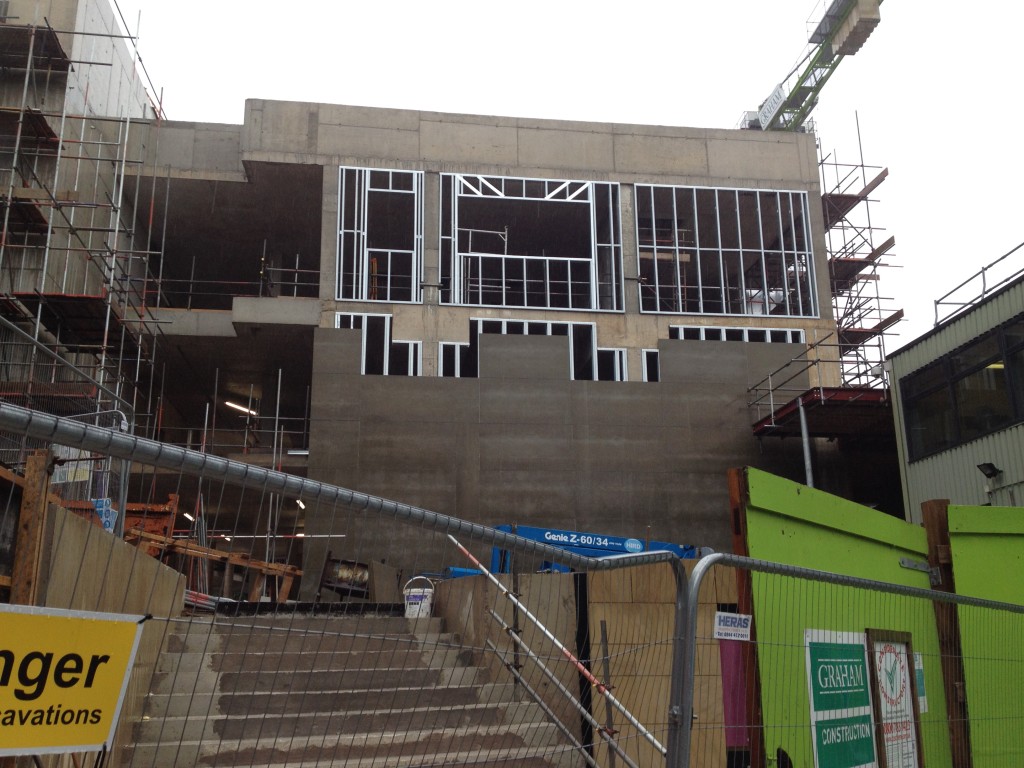
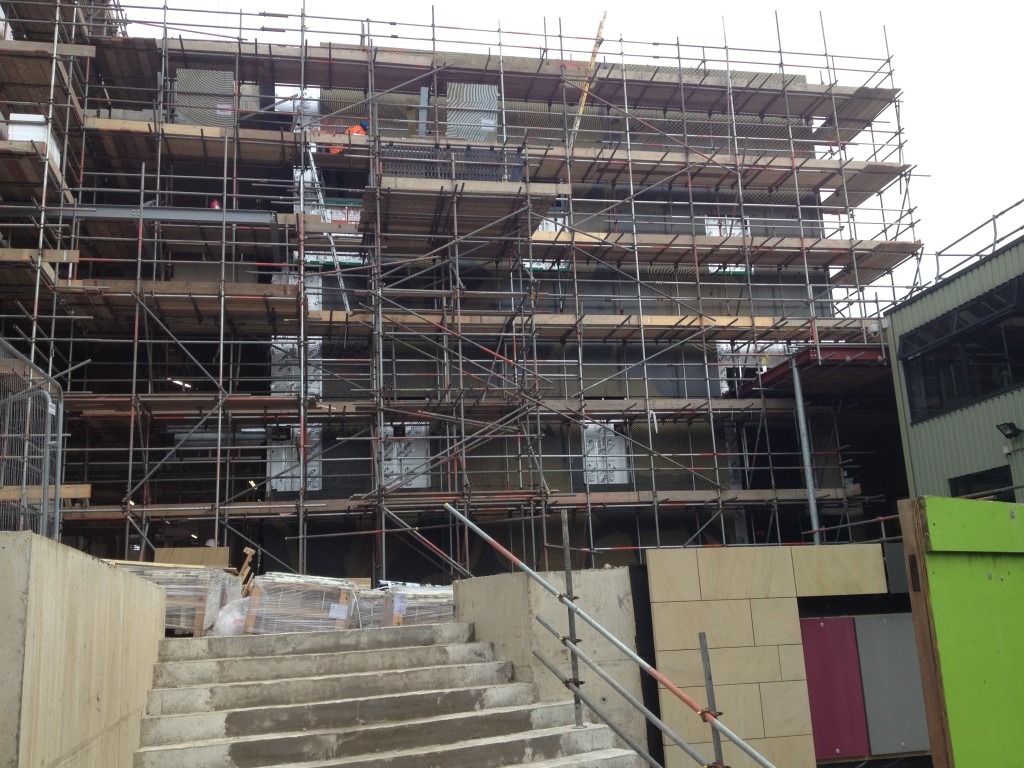
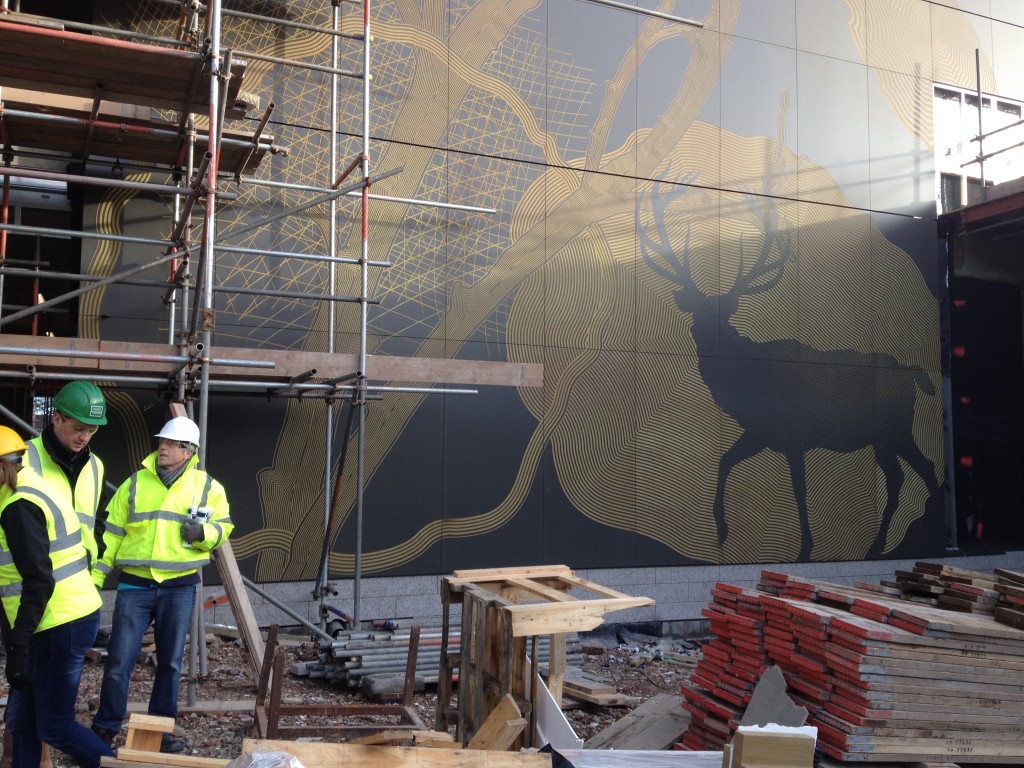
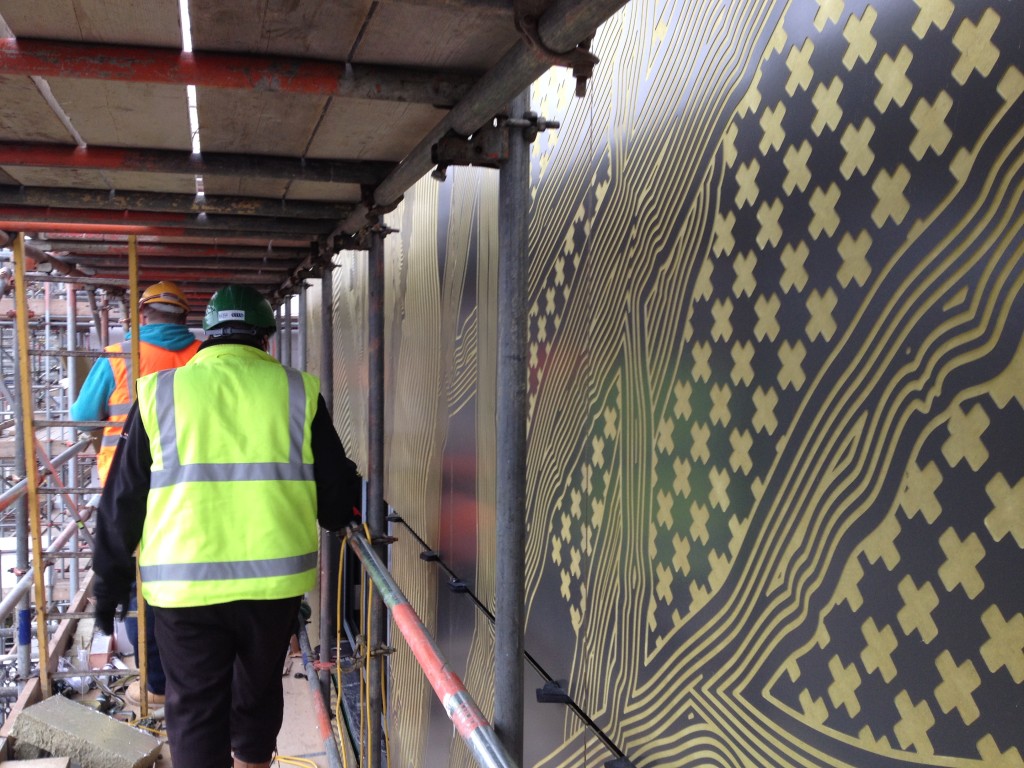

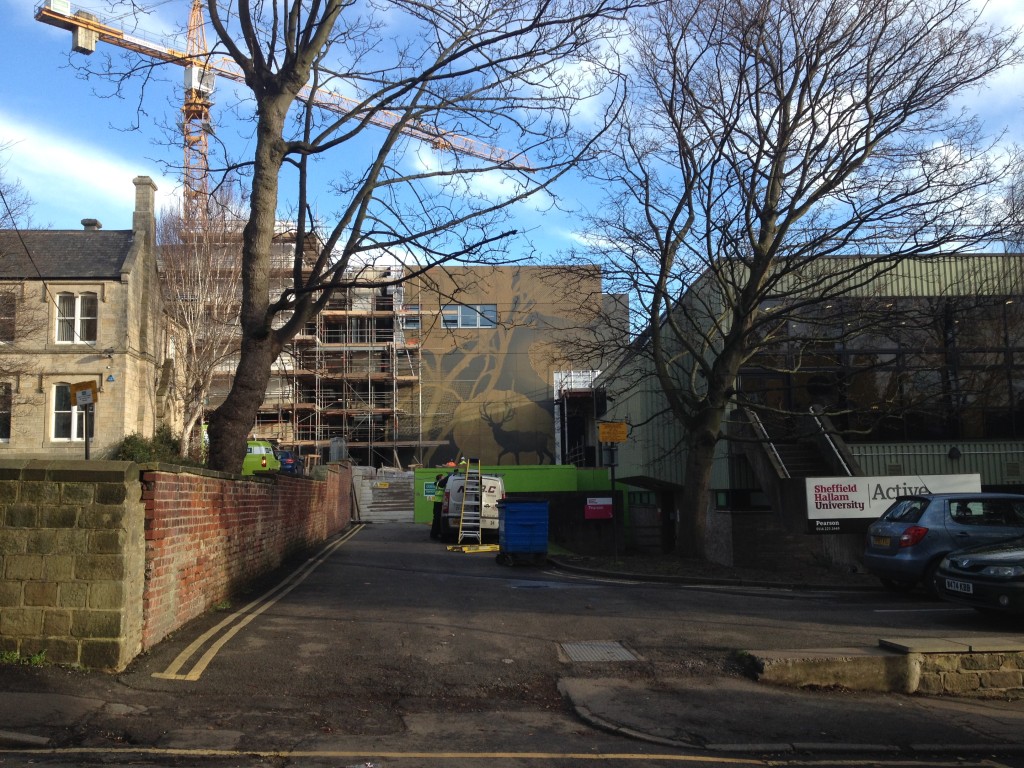
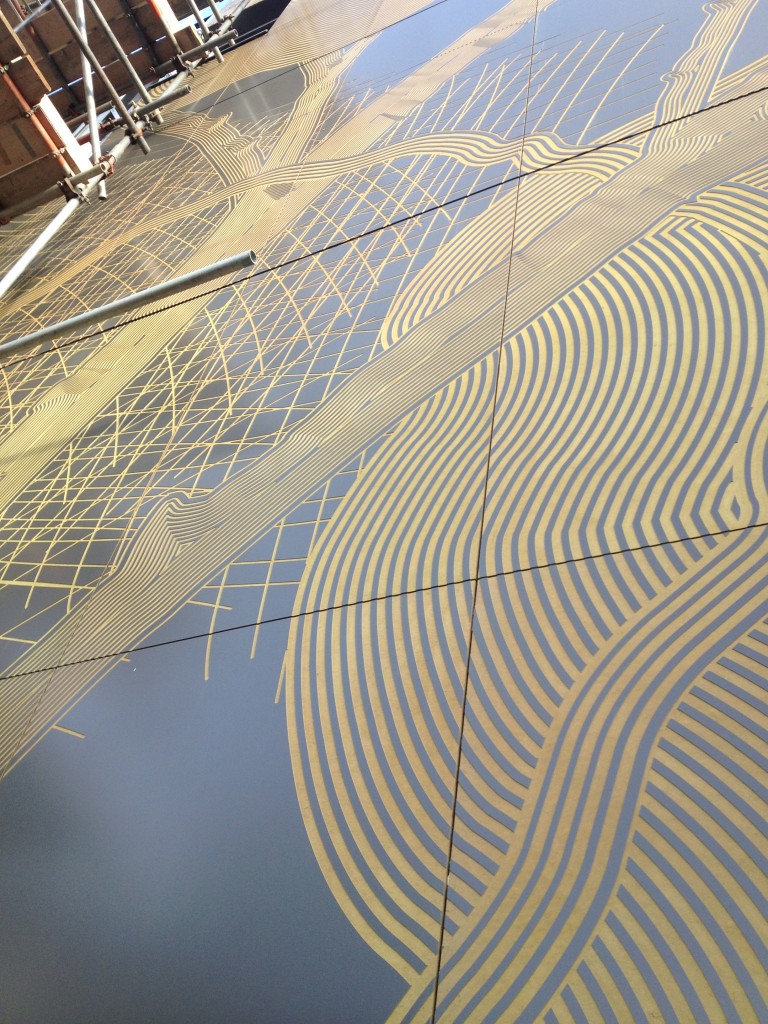
Heart of the Campus – Design Approval
On Monday 23rd July, the draft designs for the Heart of the Campus project were approved by the board. I am now starting to work with the Cutting Room in Huntingdon to begin sampling the cnc routing process.
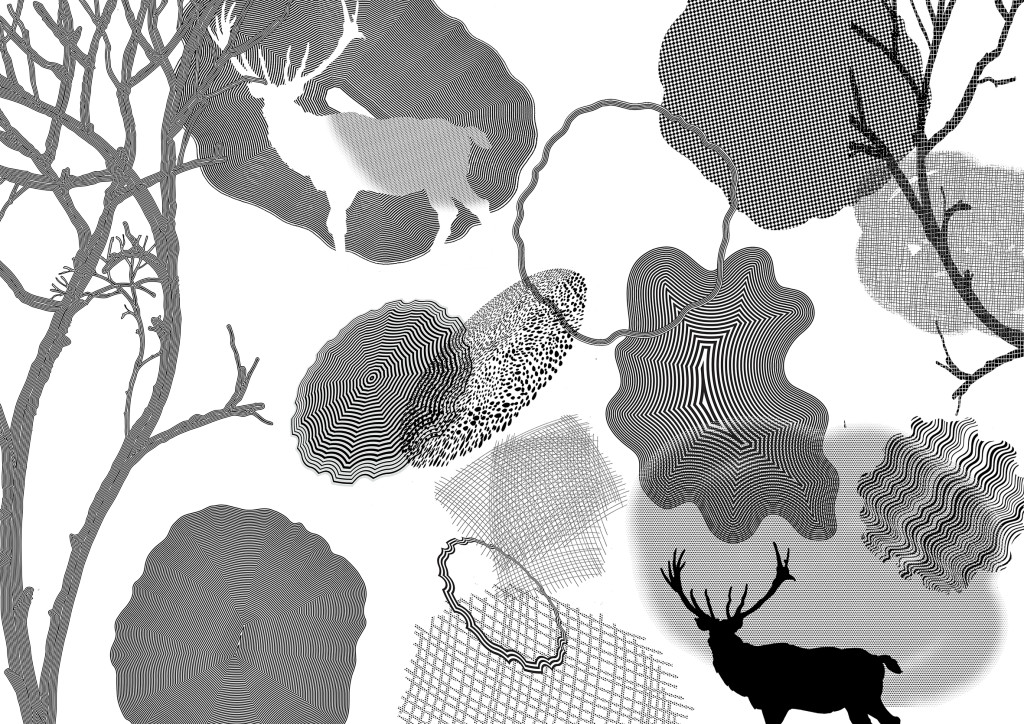

‘Bransholme Seed Cloud’. Winifred Holtby & Tweendykes Schools
‘Bransholme Seed Cloud’
The area around Bransholme has been farmed, cultivated, reclaimed & regenerated slowly over a period of 1000 years. In 1966 the green landscape of ditches & fields was to change dramatically & radically with the building of the new satellite town of Bransholme, now home to over 30,000 people.
The area is still rich in its bio-diversity. The streams, ditches, drains & dykes which dissect Bransholme & its surrounding land provide habitat for a diverse flora & fauna.
At the very heart of Bransholme stands the new Winifred Holtby Secondary and Tweendykes Special School.
This project was inspired by the locality and its rich history and topography. It was equally driven by the relationship which developed within the project team, which included both Head Teachers.
The artwork was digitally printed onto optically clear vinyl & applied to the curtain wall glazing, which spanned both school environments at Winifred Holtby & Tweendykes Schools. It was manufactured & installed by Artworks Solutions Ltd. The new Schools are part of a ‘Building Schools for the Future’ initiative.
Client: Esteem Consortium, Morgan Sindall & JM Architects with Art Consultant Andrew Knight.

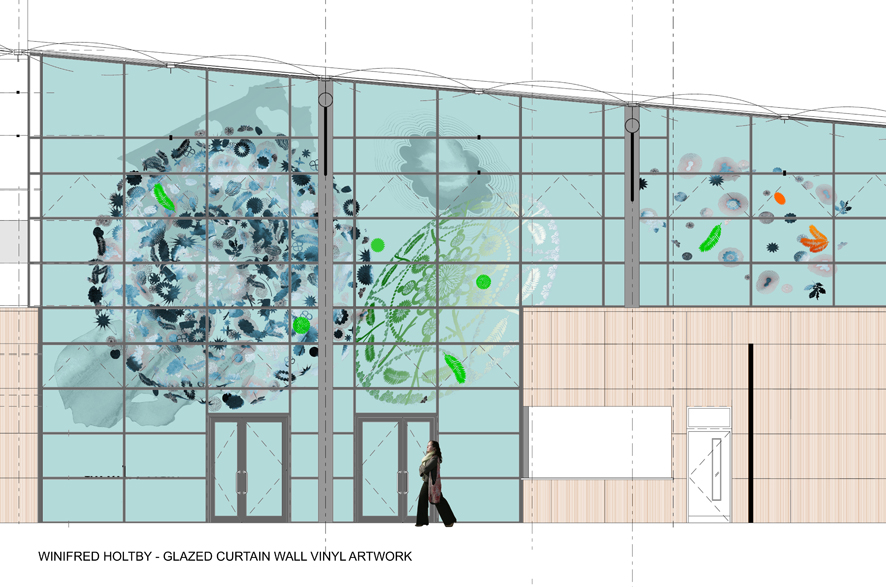
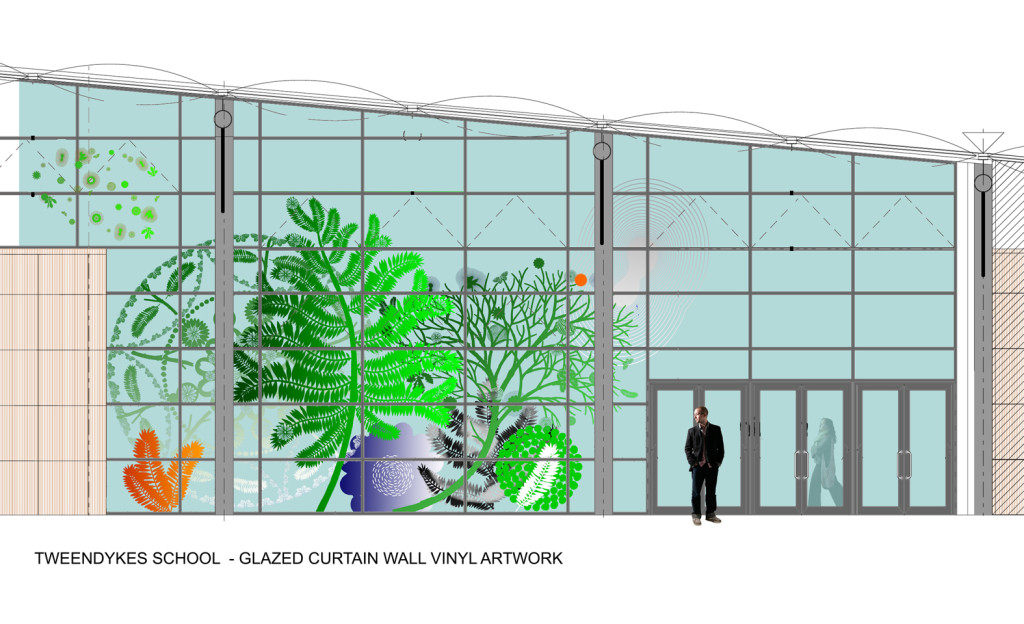
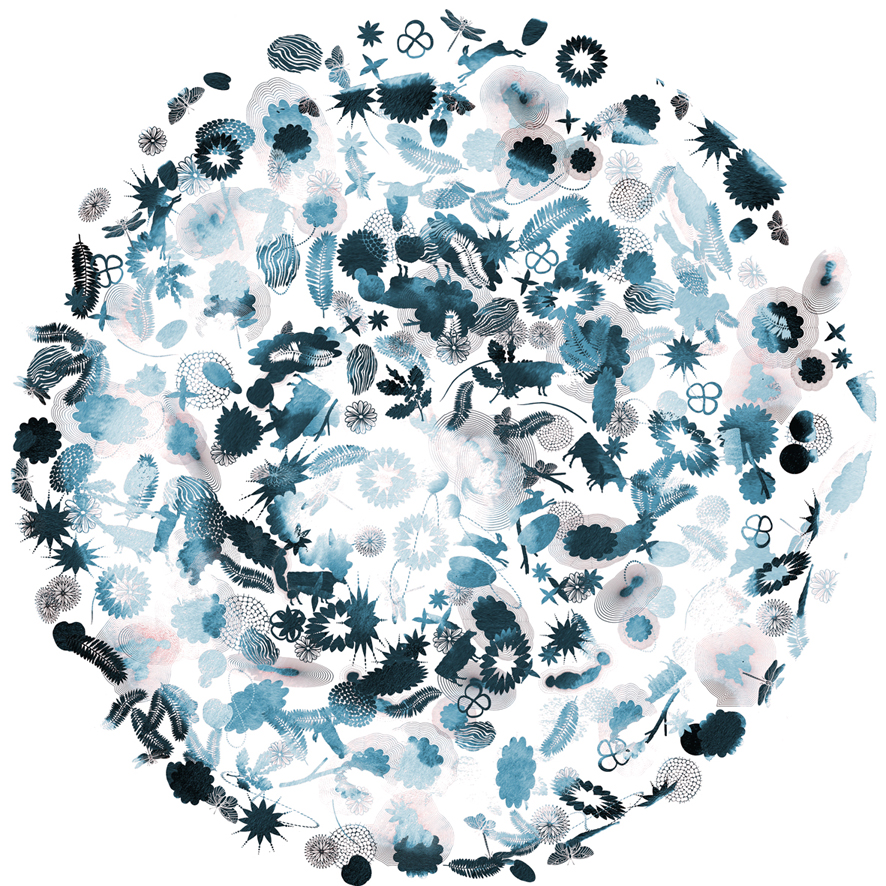
iconography set into the maelstrom cloud.
